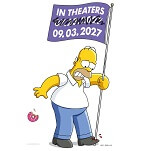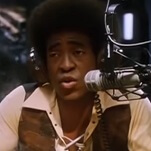Gone In 60 Seconds

It's probably an overstatement to say that producer Jerry Bruckheimer makes films that everyone sees and no one likes, but there's truth to it. Try mustering a warm feeling for Con Air or Armageddon today and you might strain yourself. Since 1995's The Rock, Bruckheimer and a rotating cast of directors have practiced a frenetically edited, visually excessive style of filmmaking that possesses the synthetic energy, long-term satisfaction, and tendency to induce headaches of an intense caffeine buzz. Bruckheimer's trick is relatively simple: Make every scene, no matter how mundane, look like the climax, reduce dialogue whenever possible, and never linger on a single shot for more than two blinks of the eye. The approach works in the short term, but it seldom adds up to much. Bruckheimer's latest, Gone In 60 Seconds, takes its title, basic premise, and a few gags from a 1974 exploitation film of the same name by used-car dealer turned actor-director H.B. Halicki. Though not much of a movie, the low-budget original delivered on its tagline's simple promise of destroying "93 cars in 40 minutes." Those who wanted to see such a spectacle knew where to go, while all others knew to stay away, if only because the sole actor billed in the opening credits was a car named Eleanor. The new Gone In 60 Seconds, on the other hand, uses Nicolas Cage (Best Actor 1995), Angelina Jolie (Best Supporting Actress 1999), Robert Duvall (Best Actor 1983), and an assortment of overqualifieds (Delroy Lindo, Giovanni Ribisi, Christopher Eccleston) to tell the story of a retired car thief (Cage) forced to steal 50 cars in one night to save his brother's life. Is it Bruckheimer business as usual? More or less, but mostly less. Though they include plenty of the standard touches—random blasts of flames, figures striding in synchronized slow motion, of-the-moment hip-hop and techno-pop, characters with names like "The Sphinx"—first-time Bruckheimer charge Dominic Sena (Kalifornia) and screenwriter Scott Rosenberg (Con Air) make a movie that's not just bad, but dull. Car fetishists and professional thieves might appreciate the way Gone lingers over the minute details of Cage's trade, but for others, it makes stealing a car look only slightly more exciting than taking one out for a Sunday cruise. Even the expected high-speed shenanigans don't arrive until a late-film chase through (big surprise) the Los Angeles reservoir, and the cast does little to help. Cage's patented overacting at least made Con Air slightly less toxic, but here he seems content to do as little as possible, while Duvall and Jolie deliver little more than cameos, readily surrendering screen time to a digestively troubled dog and countless close-up reaction shots of Cage driving. Smart move on their part: This is substance-free formula sent careening into a brick wall.








































